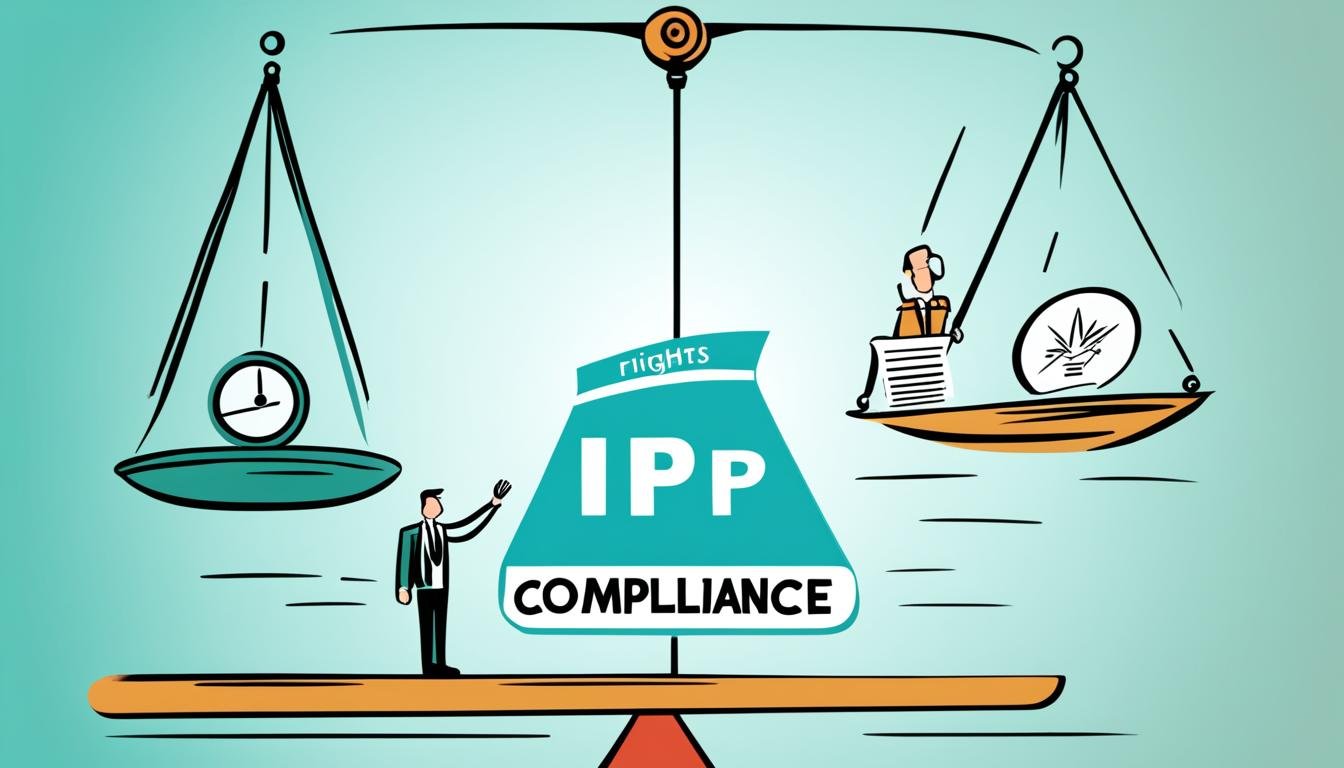Intellectual Property Rights and Compliance Guide
Did you know that only 24% of companies have a documented intellectual property (IP) strategy in place? This shocking statistic highlights the widespread lack of understanding and compliance when it comes to protecting valuable creative assets.
Intellectual Property Culture: Strategy and Compliance is a comprehensive guide designed to help companies navigate the complexities of IP compliance and ensure legal protection for their innovative ideas. Written by Eric M. Dobrusin and Ronald A. Krasnow, this invaluable resource provides practical advice and resources to develop a business culture that effectively manages and safeguards IP assets.
Key Takeaways:
- Developing an IP compliance culture is crucial for safeguarding creative assets.
- Legal counsel plays a vital role in ensuring IP compliance and managing strategic deals.
- Understanding and protecting IP rights is essential to avoid costly legal disputes.
- Effective trade secrets and data protection measures are vital for IP compliance.
- Building a comprehensive IP strategy is crucial for business success and asset management.
Understanding Intellectual Property Culture
Intellectual Property Culture: Strategy and Compliance emphasizes the importance of building a business culture that prioritizes the development and management of intellectual property. By nurturing an environment that recognizes the value of intellectual property assets, companies can protect their creative works, inventions, and trademarks while gaining a competitive edge in the market.
Integrating intellectual property (IP) into the fabric of an organization requires a comprehensive understanding of its significance and strategic utilization. In this section, we explore the core concepts and strategies behind fostering a strong intellectual property culture within your company.
The Importance of Intellectual Property
Intellectual property encompasses a broad range of assets such as patents, copyrights, trademarks, and trade secrets. These intangible assets contribute significantly to a company’s value and market presence. Understanding the role of intellectual property and its potential impact on business success is crucial for executives, attorneys, and business professionals.
When intellectual property assets are effectively protected and leveraged, they can generate revenue, enhance brand reputation, and provide a competitive advantage in the marketplace. By integrating IP into your business culture, you can create an environment where IP assets are valued, nurtured, and utilized strategically.
Developing a Culture of Intellectual Property Protection
Building a culture that prioritizes the protection of intellectual property requires a strategic approach and active involvement across all levels of the organization. Here are key strategies to develop an IP-conscious business culture:
- Educate employees about the importance of intellectual property and their role in its protection.
- Establish clear IP policies and guidelines to ensure compliance and prevent unintentional infringement.
- Implement robust security measures to safeguard valuable trade secrets and confidential information.
- Encourage innovation and creativity within the organization to foster the generation of new IP assets.
- Regularly review and update IP strategies to align with evolving business goals and market dynamics.
By implementing these strategies, businesses can develop a culture that promotes the protection, appreciation, and utilization of intellectual property assets.
Real-World Examples and Practical Advice
“Creating an intellectual property culture not only safeguards your company’s creative assets but also fosters an environment of innovation and value creation. In our book, Intellectual Property Culture: Strategy and Compliance, we share real-world examples and practical advice on how to integrate IP into the fabric of your organization. By building a culture that respects and leverages intellectual property, you can position your company for long-term success.”
– Eric M. Dobrusin and Ronald A. Krasnow, Authors of Intellectual Property Culture: Strategy and Compliance
Throughout the book, you’ll gain valuable insights from the authors’ real-world experiences. Their expertise and practical advice will assist you in developing a business culture that recognizes the importance of intellectual property and maximizes its potential.
| Benefits of an Intellectual Property Culture | Strategies for Building an IP Culture |
|---|---|
| 1. Protection of creative assets 2. Competitive edge in the market 3. Revenue generation through licensing and IP monetization |
1. Employee education and awareness 2. Establishing clear IP policies and guidelines 3. Valuing and encouraging innovation and creativity 4. Regularly reviewing and updating IP strategies |
The Role of Counsel in IP Compliance
Intellectual Property Culture: Strategy and Compliance underscores the paramount importance of IP counsel in ensuring effective IP compliance for businesses. Legal professionals play a critical role in developing strategic deals and managing a company’s IP assets. They are responsible for navigating the complexities of IP laws and guiding executives in implementing robust IP strategies.
With their extensive experience in both law and business, IP counsel offers invaluable insights and advice to organizations seeking to protect and maximize the value of their IP assets. They possess a comprehensive understanding of the legal landscape and work collaboratively with executives to align IP strategies with business objectives.
Strategic deals are a primary focus of IP counsel, who are adept at negotiating and structuring agreements that safeguard a company’s IP rights. They analyze the risks and rewards of potential collaborations, licensing arrangements, and mergers and acquisitions to ensure that the company’s IP assets are protected and leveraged effectively.
Counsel also plays a crucial role in asset development, working closely with inventors, researchers, and business teams to identify and secure IP rights. They advise on patent, trademark, and copyright filings, ensuring that the company’s IP portfolio is comprehensive and properly protected.
In addition to transactional matters, IP counsel helps companies navigate the complexities of IP litigation, enforcing their IP rights and defending against infringement. They provide strategic guidance, work with external counsel, and represent the company’s interests in court.
IP counsel is instrumental in guiding executives through the intricacies of IP compliance. By providing expert legal advice and strategic insight, they ensure that companies develop and implement effective IP strategies—ultimately safeguarding their valuable IP assets and maintaining a competitive edge in the market.
To further illustrate the importance of IP counsel, consider the following example:
| Scenario | Role of IP Counsel |
|---|---|
| A company is exploring a strategic partnership with a technology firm to develop an innovative product. |
|
The expertise and guidance provided by IP counsel are essential for companies to navigate the complex landscape of IP compliance. Their strategic counsel, combined with a deep understanding of IP laws, enables businesses to effectively protect their IP assets, facilitate strategic deals, and foster innovation.
Protecting Intellectual Property Rights
Intellectual Property Culture: Strategy and Compliance provides valuable insights into the legal mechanisms for protecting intellectual property rights. This section explores key topics such as copyright infringement, trademark law, and patent enforcement. By understanding these aspects, companies can proactively safeguard their IP assets, avoiding costly legal disputes and maintaining a competitive edge in the market.
Copyright Infringement
Copyright infringement occurs when someone uses, copies, or distributes copyrighted works without permission. This can include literary, artistic, musical, or visual works. To protect against infringement, companies should register their copyrights with the appropriate authorities and monitor unauthorized use of their works.
Trademark Law
Trademark law governs the protection of brand names, logos, and symbols that differentiate one company’s products or services from others. Companies can apply for trademark registration to establish exclusive rights to their marks and prevent others from using confusingly similar marks in commerce.
Patent Enforcement
Patent enforcement refers to the legal actions taken to protect a company’s inventions or discoveries. By obtaining patents, companies can prevent others from making, using, or selling their patented inventions without authorization. Patent enforcement ensures that companies can benefit from their innovative solutions and maintain a competitive advantage.
“Protecting intellectual property rights is of paramount importance for businesses in today’s knowledge-based economy. It requires a comprehensive understanding of copyright, trademark, and patent laws to effectively safeguard creative works, brand identity, and technological innovations.”
Intellectual Property Culture: Strategy and Compliance offers practical tips and best practices to help companies protect their creative works, logos, and inventions. By implementing robust IP protection strategies, businesses can mitigate the risk of infringement, establish brand recognition, and secure their market position.
Stay tuned for the next section, where we will delve into the importance of trade secrets and data protection in intellectual property compliance.
Trade Secrets and Data Protection
Intellectual Property Culture: Strategy and Compliance recognizes the significance of trade secrets and data protection in maintaining IP compliance. It provides valuable insights into how companies can effectively safeguard their trade secrets, confidential information, and proprietary data through the implementation of robust IP policies and programs.
Developing comprehensive IP policies is instrumental in ensuring the protection of valuable trade secrets and other sensitive data. These policies outline guidelines and procedures for handling and preserving confidential information within the organization. By establishing clear protocols for data protection, companies can significantly mitigate the risk of unauthorized access and misuse.
Employee training plays a crucial role in enforcing IP policies and fostering a culture of data protection. Training programs should educate employees about the importance of confidentiality and instill best practices for safeguarding sensitive information. By raising awareness and empowering employees with knowledge, companies can create a workforce that is actively committed to protecting trade secrets and upholding data security.
“The success of any data protection program lies in both policy development and employee education. By implementing effective policies and providing comprehensive training, organizations can effectively safeguard their trade secrets and confidential data.” – Eric M. Dobrusin and Ronald A. Krasnow
To assist organizations in developing their IP policies and training programs, Intellectual Property Culture provides sample agreements and resources that cover various aspects of data protection. These resources serve as valuable references for companies seeking to establish robust data protection frameworks in compliance with IP regulations.
Furthermore, the book highlights the importance of complying with data protection regulations imposed by governing bodies. It emphasizes the need for companies to understand and adhere to the applicable data protection laws to ensure compliance and avoid legal consequences.
| Key Points | Benefits |
|---|---|
| Developing comprehensive IP policies | – Protection of valuable trade secrets – Enhanced data security – Compliance with IP regulations |
| Employee training | – Awareness and understanding of data protection – Active commitment to trade secret protection – Mitigation of data security risks |
| Sample agreements and resources | – Practical references for IP policy development – Insights into industry best practices – Assistance in implementing data protection frameworks |
| Data protection compliance | – Adherence to data protection laws – Avoidance of legal consequences – Maintenance of a trustworthy public image |
By prioritizing trade secrets and data protection, companies can reinforce their intellectual property rights and establish a strong foundation for compliance with IP policies. Intellectual Property Culture: Strategy and Compliance serves as a comprehensive guide for organizations seeking to safeguard their valuable assets and navigate the complexities of data protection.
International Intellectual Property Strategies
When it comes to protecting intellectual property (IP) assets, a company’s strategy must extend beyond its national boundaries. In an increasingly globalized marketplace, understanding international IP strategies is essential for businesses aiming for long-term success. This section of the Intellectual Property Culture: Strategy and Compliance guide explores the complexities and considerations involved in developing effective international IP strategies.
The Importance of Global IP Protection
In today’s interconnected world, companies need to protect their IP assets across different jurisdictions. This is especially crucial in countries known for counterfeiting markets or those with free trade agreements that present unique challenges and opportunities. Filing for IP protection globally ensures comprehensive coverage and helps safeguard a company’s competitive advantage in the global marketplace.
Navigating Cross-Border Protection
Each country has its own set of regulations and requirements for patent and trademark registration. To navigate cross-border protection effectively, businesses must understand the differences in patent and trademark registration processes across jurisdictions. This knowledge allows companies to develop a tailored approach and maximize the potential protection for their IP assets.
Considerations for Expanding Operations Globally
Expanding operations globally involves multiple considerations, including comprehensive IP protection. International IP strategies must align with business goals and adapt to the legal environments of different countries. Companies need to be mindful of cultural differences, language barriers, and changes in intellectual property laws to build a strong foundation for their global expansion.
“Expanding operations globally without a comprehensive IP strategy is akin to leaving your creative assets exposed to potential infringements and loss of market advantage.”
A Holistic Approach to IP Protection
International intellectual property strategies require a holistic approach that accounts for the unique challenges presented by global markets. By considering regional nuances, engaging local counsel, and staying informed about evolving regulations, companies can develop robust strategies that ensure their IP assets are protected against infringement and misappropriation.
| Common Challenges | Solutions |
|---|---|
| Lack of familiarity with international IP laws and regulations | Engage experienced international IP counsel and conduct thorough research |
| Differences in patent and trademark registration processes | Partner with experts to navigate the intricacies of each jurisdiction |
| Risks associated with counterfeiting markets | Implement robust monitoring and enforcement strategies to combat counterfeiting |
By proactively addressing these challenges and considering the broader global IP landscape, businesses can protect their valuable IP assets and maintain a competitive edge in the international marketplace.
Regulatory Compliance and Intellectual Property
The intersection of regulatory compliance and intellectual property is a crucial consideration for businesses operating in today’s fast-paced and highly regulated environment. Intellectual Property Culture: Strategy and Compliance addresses the impact of IP laws on organizational compliance efforts and provides guidance on ensuring alignment with relevant regulations. In particular, the book delves into the implications of the America Invents Act of 2011, a landmark piece of legislation that significantly transformed the intellectual property landscape in the United States.
The America Invents Act: A Shift in IP Compliance
The America Invents Act introduced significant changes to the U.S. patent system, aiming to harmonize the country’s IP laws with international standards and enhance the efficiency and quality of patent examination processes. Among the key provisions of the act were the switch to a first-inventor-to-file system, the establishment of post-grant review proceedings, and the creation of new post-issuance proceedings for challenging patents.
This legislation ushered in a new era of IP compliance, requiring businesses to adapt their strategies and practices to align with the evolving legal landscape. By understanding the implications of the America Invents Act, companies can proactively develop policies and practices that comply with IP laws, mitigate infringement risks, and safeguard their intellectual property assets.
Practical Tips for IP Compliance
“Effective compliance with IP laws requires a proactive approach that includes a robust understanding of the regulatory framework, regular evaluations of business practices, and diligent enforcement of IP rights.”
Intellectual Property Culture: Strategy and Compliance offers practical tips and resources to help businesses navigate the complexities of IP compliance. The book guides companies in developing policies and practices that not only comply with IP laws and regulations but also empower them to proactively protect their intellectual property assets.
Key areas covered in the book include:
- Developing comprehensive IP policies and practices
- Evaluating and mitigating infringement risks
- Establishing protocols for IP due diligence
- Enforcing IP rights through monitoring and enforcement strategies
By following these best practices, organizations can create a culture of compliance that upholds the integrity of their intellectual property assets and minimizes legal and reputational risks.
| IP Laws | Key Regulations | |
|---|---|---|
| Copyright | • U.S. Copyright Act | • Digital Millennium Copyright Act (DMCA) |
| Trademark | • Lanham Act | • Madrid System |
| Patent | • U.S. Patent Act | • Patent Cooperation Treaty (PCT) |
| Trade Secret | • Uniform Trade Secrets Act (UTSA) | • Economic Espionage Act |
This table highlights some of the key IP laws and regulations that businesses must navigate to maintain compliance. Familiarity with these laws and their corresponding regulations is essential for organizations seeking to protect their intellectual property assets while operating within legal frameworks.
Intellectual Property Culture: Strategy and Compliance equips businesses with the knowledge and tools they need to understand and meet the demands of regulatory compliance in the context of intellectual property. By embracing a proactive and comprehensive approach to IP compliance, organizations can position themselves for success in intellectual property management and protection.
The Importance of Intellectual Property Training
Intellectual Property Culture: Strategy and Compliance emphasizes the significance of providing comprehensive intellectual property (IP) training to employees. Educating staff on IP concepts, policies, and best practices is crucial for building a knowledgeable and IP-aware workforce.
By offering IP education, organizations can reap several benefits:
- Increased awareness: Employees gain a deeper understanding of the importance of IP protection and compliance.
- Reduced risks: Well-informed employees are less likely to engage in activities that could infringe on IP rights.
- Improved collaboration: A shared understanding of IP encourages cross-functional teams to work together to maximize IP assets.
- Enhanced innovation: IP training fosters a culture of creative thinking, fueling the development of new ideas and inventions.
- Protection of trade secrets: Training equips employees with the knowledge to safeguard proprietary information and trade secrets.
Organizations can utilize sample training materials and resources provided in Intellectual Property Culture: Strategy and Compliance to facilitate effective IP education. These resources include:
- Guides on IP basics, including copyright, trademarks, and patents
- Case studies illustrating real-world IP challenges and solutions
- IP policy templates
- Training videos and presentations
In addition to training, it is essential to keep employees informed about the company’s IP portfolio. Regular patent status reports can update staff on the progress and status of key patents, fostering a sense of involvement and ownership.
“Effective intellectual property training empowers employees to become guardians of your company’s creative assets, ensuring compliance and fostering a culture of innovation.”
To highlight the significance of this topic, the table below summarizes key statistics related to employee training, IP education, and the impact of patent status reports:
| Statistics | Findings |
|---|---|
| IP Training Effectiveness | Companies that provide IP training to employees experience a significant reduction in IP infringement incidents. |
| Employee Awareness | Only 37% of employees have a basic understanding of IP concepts, highlighting the need for comprehensive education and training. |
| Patent Status Reports | Organizations that regularly communicate patent status updates to employees report higher levels of engagement and a greater sense of responsibility towards IP protection. |
By investing in employee training, organizations can cultivate a culture of intellectual property awareness and compliance, safeguard valuable IP assets, and drive innovation.
Jurisdiction and Remedies in IP Cases
In the realm of intellectual property, jurisdiction plays a critical role in resolving disputes and seeking appropriate remedies. Intellectual Property Culture: Strategy and Compliance provides valuable insights into the complexities of jurisdiction and the remedies available in IP cases. This section explores the challenges of determining the appropriate legal jurisdiction for IP disputes and offers practical guidance on seeking effective remedies to protect and enforce IP rights.
“Jurisdiction is a crucial aspect of intellectual property cases, as it determines which court has the authority to hear and decide on a dispute,” explains Eric M. Dobrusin and Ronald A. Krasnow in Intellectual Property Culture: Strategy and Compliance. “Understanding the nuances of jurisdiction is essential for organizations to effectively navigate the legal landscape and safeguard their intellectual property.”
The determination of jurisdiction in IP cases involves various factors, such as the location of the parties involved, the place where the alleged infringement occurred, and the laws governing the specific intellectual property rights. It can be complex, especially in cases with international dimensions.
When it comes to seeking remedies in IP cases, the authors highlight the importance of understanding the available options. They delve into recent Supreme Court patent cases that have significantly influenced IP law, offering insights into the legal principles guiding the selection and pursuit of remedies.
Whether it’s seeking injunctive relief, damages, or other forms of relief, Intellectual Property Culture: Strategy and Compliance equips readers with practical guidance on navigating the legal system to protect and enforce their IP rights effectively.
Recent Supreme Court Cases Shaping IP Jurisdiction and Remedies
| Case | Key Principles |
|---|---|
| Alice Corp. v. CLS Bank International | Established the framework for determining patent eligibility, addressing the issue of abstract ideas and patentability. |
| TC Heartland LLC v. Kraft Foods Group Brands LLC | Created limitations on venue choices by emphasizing the significance of a defendant’s “residence” for determining jurisdiction. |
| Octane Fitness, LLC v. Icon Health & Fitness, Inc. | Expanded the availability of attorneys’ fees in exceptional patent litigation cases, giving more discretion to district courts. |
These landmark Supreme Court cases, along with others, have shaped the current IP legal landscape, influencing the determination of jurisdiction and the pursuit of appropriate remedies.
By understanding jurisdiction and the available remedies in IP cases, organizations can optimize their IP strategies, protect their intellectual property rights, and ensure a strong position in today’s competitive marketplace.
Building a Successful Intellectual Property Strategy
Intellectual Property Culture: Strategy and Compliance provides invaluable guidance for companies looking to develop a successful intellectual property strategy. This section explores practical advice on aligning IP strategies with business development goals and effectively managing IP assets. By implementing the strategies outlined in this book, organizations can maximize the value of their IP portfolio and achieve their business objectives.
Aligning IP Strategies with Business Development Goals
Effective integration of IP strategies with business development goals is essential for long-term success. Intellectual Property Culture: Strategy and Compliance offers insights on how companies can align the development and management of IP assets with their overall business objectives. By adopting a strategic approach to IP, organizations can leverage their intellectual property to drive growth, enhance competitiveness, and secure a strong market position.
Effective Management of IP Assets
Managing IP assets is a vital component of any successful intellectual property strategy. This section of Intellectual Property Culture: Strategy and Compliance delves into proven techniques for effectively managing IP assets throughout their lifecycle. It provides practical advice on maintaining accurate and up-to-date records, conducting regular IP audits, and implementing comprehensive asset management processes. By ensuring proper management of their IP assets, organizations can protect their valuable intellectual property and capitalize on its full potential.
“A well-executed intellectual property strategy can unlock tremendous opportunities for business growth while safeguarding valuable intangible assets.” – Eric M. Dobrusin, Ronald A. Krasnow
Sample Agreements, Timelines, and Questionnaires
Intellectual Property Culture: Strategy and Compliance equips organizations with valuable resources to develop a comprehensive IP strategy. The book offers sample agreements, timelines, and questionnaires to facilitate the strategic planning and execution of IP initiatives. These practical tools enable companies to assess their IP position, identify gaps and risks, and formulate effective action plans to protect and leverage their intellectual property.
Implementing a successful intellectual property strategy is crucial for businesses striving to stay competitive in today’s dynamic marketplace. By following the guidance provided in Intellectual Property Culture: Strategy and Compliance, companies can unlock the full potential of their intellectual property assets and propel their business forward.
Conclusion
In conclusion, the Intellectual Property Culture: Strategy and Compliance Guide is an indispensable resource for companies navigating the complexities of intellectual property rights and compliance. Authored by experienced professionals Eric M. Dobrusin and Ronald A. Krasnow, this comprehensive guide offers practical tips, sample agreements, and valuable insights to help businesses protect their creative assets, ensure IP compliance, and develop effective IP strategies. Whether you’re an attorney, executive, or business professional, this guide is a must-have tool for successfully managing intellectual property in today’s highly competitive landscape.
By following the guidance provided in this Intellectual Property Rights and Compliance Guide, companies can safeguard their creative assets from infringement and unauthorized use. It provides a roadmap for IP compliance and offers practical solutions to address the legal and regulatory challenges surrounding intellectual property rights. This guide empowers businesses to proactively protect their valuable IP assets, mitigate risks, and maintain a competitive edge.
Protecting creative assets is of paramount importance in today’s digital age. The Intellectual Property Culture: Strategy and Compliance Guide equips companies with the knowledge and tools necessary to navigate the nuances of IP laws and regulations. By implementing the strategies outlined in this guide, businesses can foster an IP-conscious culture, ensure regulatory compliance, and leverage their intellectual property for growth and success.








